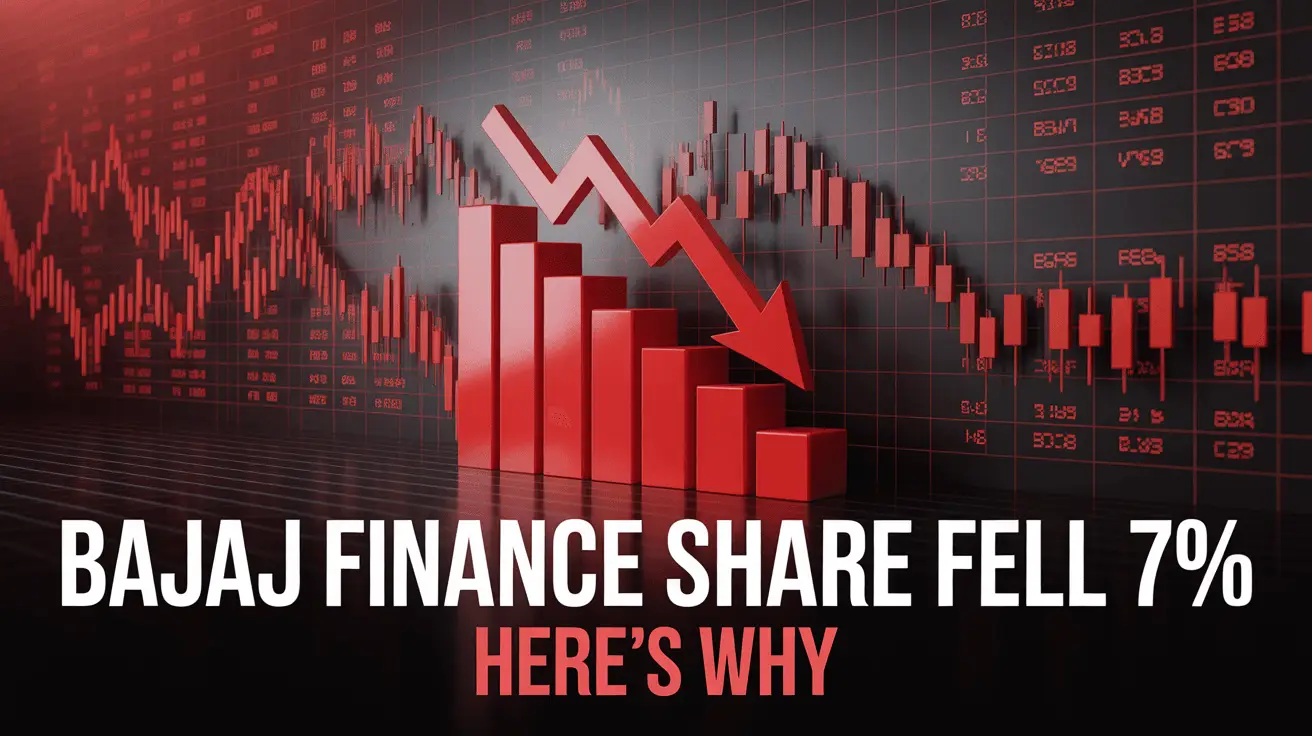Bajaj Finance shares witnessed a sharp decline of 7-8% on November 11, 2025, despite posting a robust 23% year-on-year increase in consolidated net profit for Q2 FY26. The stock plunged to Rs 1,003 per share, leaving investors puzzled about why strong earnings failed to support the share price. The answer lies in a combination of reduced growth guidance, rising asset quality concerns, and heightened credit costs that have triggered widespread investor anxiety.
Table of Contents
- Bajaj Finance Q2 FY26 Performance Overview
- 5 Critical Reasons Why Bajaj Finance Stock is Falling
- 1. Reduced Growth Guidance for FY26
- 2. Rising Asset Quality Concerns and NPAs
- 3. Elevated Credit Costs Impacting Profitability
- 4. Stress in MSME and Two/Three-Wheeler Loan Segments
- 5. Analyst Downgrades and Target Price Cuts
- What Should Investors Do Now?
- Frequently Asked Questions
Bajaj Finance Q2 FY26 Performance Overview
Bajaj Finance Limited reported strong financial results for the September 2025 quarter, with consolidated net profit rising 23% year-on-year to Rs 4,950 crore. The company’s assets under management (AUM) grew by an impressive 24% YoY to Rs 4,62,250 crore, while new loans booked during the quarter increased 26% to 12.17 million. The Net Interest Margin (NIM) remained stable at 9.55%, and the deposit book expanded to Rs 69,750 crore from Rs 66,131 crore in the previous year.
Despite these impressive headline numbers, the market reacted negatively to management commentary during the earnings call, which revealed underlying challenges that could impact future growth and profitability. Understanding the difference between stock trading and investing becomes crucial during such volatile periods to make informed decisions.
| Financial Metric | Q2 FY26 | Q2 FY25 | YoY Growth |
|---|---|---|---|
| Net Profit | Rs 4,950 crore | Rs 4,027 crore | 23% |
| Assets Under Management | Rs 4,62,250 crore | Rs 3,73,013 crore | 24% |
| New Loans Booked | 12.17 million | 9.66 million | 26% |
| Gross NPA | 1.24% | 1.06% | +18 bps |
| Net NPA | 0.60% | 0.46% | +14 bps |
5 Critical Reasons Why Bajaj Finance Stock is Falling
The sharp decline in Bajaj Finance shares can be attributed to multiple factors that collectively dampened investor sentiment. While the company continues to demonstrate strong operational performance, concerns about future growth trajectory and asset quality have overshadowed current achievements. Many investors who fail to understand these nuances often end up losing money in the stock market due to panic selling or poor timing.
1. Reduced Growth Guidance for FY26
The most significant trigger for the stock decline was Bajaj Finance management’s decision to revise its FY26 AUM growth guidance downward to 22-23% from the earlier projection of 24-25%. This represents a 200 basis points cut from the initial guidance provided at the beginning of FY26. The management cited heightened competition in the mortgage segment, which accounts for 32% of total AUM, and the need for risk containment in the MSME portfolio, which forms 12% of AUM, as primary reasons for the revised forecast.
This guidance cut signals that Bajaj Finance is facing headwinds in maintaining its historically high growth rates. The mortgage business, traditionally a cornerstone of the company’s expansion strategy, is experiencing intense competition from banks and other NBFCs offering aggressive rates. Additionally, the company has adopted a more conservative approach toward MSME lending to manage portfolio quality, which directly impacts overall growth momentum.
2. Rising Asset Quality Concerns and NPAs
Asset quality deterioration emerged as a major concern for investors. Gross Non-Performing Assets (NPAs) rose to 1.24% of total loans by September 2025, up from 1.06% a year ago, representing an 18 basis points increase. Net NPAs climbed to 0.60% from 0.46%, marking a 14 basis points rise. This deterioration is particularly concerning because it occurred during a period when most other NBFCs and banks reported improving asset quality metrics.
The rising NPA trend indicates that certain segments of Bajaj Finance’s diverse lending portfolio are experiencing repayment stress. The company operates across multiple lending verticals including consumer durables, personal loans, business loans, rural lending, and mortgages. While diversification typically reduces risk, the current environment shows that stress is appearing across multiple segments simultaneously, which amplifies the overall impact on asset quality.
3. Elevated Credit Costs Impacting Profitability
Credit costs increased significantly during Q2 FY26, with loan losses and provisions rising 19% to Rs 2,269 crore. This pushed annualized credit costs to 2.05% of average assets, remaining at the higher end of the company’s guidance range. The management indicated that credit costs could stay elevated through the rest of the year, limiting room for margin improvement and profitability expansion.
Higher provisioning requirements directly impact bottom-line growth and return ratios. While Bajaj Finance has guided for credit costs of 1.85-1.95% for the full year, the Q2 performance suggests pressure on this metric. The company expects some improvement in the second half of FY26 as stress in the captive two/three-wheeler portfolio reduces and collection efficiency improves, but significant relief is expected only in FY27. Investors who understand these dynamics are less likely to make the common mistakes that explain why investors fail in the stock market.
4. Stress in MSME and Two/Three-Wheeler Loan Segments
Management commentary highlighted specific stress in two critical portfolio segments: Micro, Small and Medium Enterprises (MSME) loans and the captive two-wheeler and three-wheeler financing business. The MSME segment, which accounts for approximately 12% of total AUM, has shown signs of delinquency as small businesses face challenges related to working capital pressures, demand slowdown, and operational difficulties in the post-pandemic economic environment.
The captive two-wheeler and three-wheeler loan portfolio, which finances Bajaj Auto vehicles, has been running down as Bajaj Finance adopted stricter underwriting standards. While this reduces future origination volumes, the existing book continues to show elevated delinquency levels. The rural B2C segment also exhibited stress, though management noted some improvement in collection efficiency in recent months. These segment-specific challenges constrain overall portfolio growth and require more conservative lending practices.
5. Analyst Downgrades and Target Price Cuts
The negative sentiment was amplified by multiple analyst downgrades and target price reductions following the Q2 results. Emkay Global downgraded Bajaj Finance to ‘Reduce’ from ‘Add’ and cut the target price to Rs 1,000 from Rs 1,075, citing concerns about gradual growth moderation and intensified competition narrowing the company’s premium valuation multiple compared to lending peers.
JM Financial Institutional Securities downgraded the stock to ‘Add’ from ‘Buy’ while raising the target to Rs 1,140 from Rs 1,060, revising EPS estimates downward by 3% for FY26 and 2% for FY27. Sanford C. Bernstein warned of long-term growth headwinds, expecting EPS growth to moderate to approximately 20% and valuing the stock at 20x trailing PE, cautioning about valuation reset risks. CLSA noted that credit costs increased 3 basis points quarter-on-quarter to 2%, driven by higher net slippages, though it acknowledged improvement in 30+ days past due formation.
| Brokerage | Rating | Target Price | Key Concern |
|---|---|---|---|
| Emkay Global | Reduce (Downgraded from Add) | Rs 1,000 | Growth moderation and competitive pressure |
| JM Financial | Add (Downgraded from Buy) | Rs 1,140 | Reduced growth guidance |
| Bernstein | Caution | 20x trailing PE | Long-term growth headwinds |
| Jefferies | Neutral outlook | Not specified | Weaker trends in SME & housing |
What Should Investors Do Now?
The current situation presents a complex decision point for both existing shareholders and potential investors considering Bajaj Finance. Long-term investors with a time horizon of 3-5 years should focus on the company’s fundamental strengths: diversified lending portfolio, strong technology infrastructure, robust distribution network with over 4,200 locations, and proven management track record. The current challenges are cyclical in nature and reflect broader economic headwinds affecting the lending industry.
Short-term traders and momentum investors, however, should exercise caution as the stock may continue to face pressure until there is clear evidence of stabilization in asset quality metrics and visible improvement in growth momentum. The revised guidance suggests that FY26 will be a year of consolidation rather than aggressive expansion, which may limit near-term upside potential. Monitoring quarterly performance, particularly improvements in 30+ DPD trends, credit cost trajectory, and segment-wise AUM growth, will be critical.
Start Your Investment Journey Today
Open a free trading and demat account with India’s leading brokers:
For investors employing a systematic investment approach, staggered accumulation at lower levels may be a prudent strategy. The stock’s valuation has become more reasonable after the recent correction, trading at approximately 20-24x forward earnings compared to historical averages of 28-30x. However, valuation alone should not drive investment decisions; qualitative factors such as competitive positioning, management’s ability to navigate challenges, and macro-economic trends should also be considered.
Risk management becomes paramount in the current scenario. Investors should avoid overconcentration in financial sector stocks and maintain portfolio diversification across sectors and asset classes. Setting clear stop-loss levels or position sizing based on risk tolerance can help protect capital during periods of heightened volatility. Additionally, staying informed about regulatory changes, RBI policy directions on lending norms, and broader economic indicators will provide context for Bajaj Finance’s performance trajectory.
Frequently Asked Questions
Why did Bajaj Finance stock fall despite good earnings?
Bajaj Finance stock fell 7-8% despite posting a 23% increase in net profit because the management revised its FY26 growth guidance downward to 22-23% from 24-25%, signaling slower future expansion. Additionally, rising NPAs, elevated credit costs, and stress in MSME and two/three-wheeler loan segments raised concerns about asset quality deterioration and profitability pressure. Markets often react to future guidance more strongly than historical performance.
What is the current NPA level of Bajaj Finance?
As of September 2025 (Q2 FY26), Bajaj Finance’s Gross Non-Performing Assets (NPAs) stood at 1.24% of total loans, up from 1.06% a year ago, while Net NPAs increased to 0.60% from 0.46% in the same period. This 18 basis points rise in Gross NPAs indicates deteriorating asset quality, particularly in MSME and captive two/three-wheeler loan segments, which has become a key concern for investors.
Should I buy Bajaj Finance stock after the recent fall?
The decision to buy Bajaj Finance stock depends on your investment horizon and risk appetite. Long-term investors with a 3-5 year time frame may find the current valuation attractive after the correction, as the company maintains strong fundamentals despite near-term challenges. However, short-term traders should wait for clearer signs of stabilization in asset quality and growth metrics. Consider staggered accumulation rather than lump-sum investment, and maintain appropriate position sizing based on your overall portfolio allocation.
What is Bajaj Finance’s growth guidance for FY26?
Bajaj Finance has revised its FY26 Assets Under Management (AUM) growth guidance to 22-23% from the earlier projection of 24-25%. This downward revision of 200 basis points reflects heightened competition in the mortgage segment, which accounts for 32% of total AUM, and risk containment measures in the MSME portfolio. The management has adopted a more conservative approach to balance growth with asset quality preservation.
Which loan segments are showing stress in Bajaj Finance portfolio?
Bajaj Finance is experiencing stress primarily in two segments: the Micro, Small and Medium Enterprises (MSME) loans, which account for approximately 12% of total AUM, and the captive two-wheeler and three-wheeler financing portfolio. The rural B2C segment also showed elevated delinquency levels, though collection efficiency has improved recently. These segments face challenges from working capital pressures, demand slowdown, and tighter underwriting standards implemented by the company.
What are analysts saying about Bajaj Finance stock?
Analyst sentiment has turned cautious following Q2 results. Emkay Global downgraded the stock to ‘Reduce’ with a target price of Rs 1,000, while JM Financial downgraded to ‘Add’ with a target of Rs 1,140. Bernstein warned of long-term growth headwinds and expects EPS growth to moderate to around 20%. Most analysts have reduced earnings estimates by 2-6% for FY26-FY27, citing slower growth guidance, elevated credit costs, and competitive pressure in key lending segments.
How does Bajaj Finance compare to other NBFCs in terms of asset quality?
Bajaj Finance’s asset quality deterioration in Q2 FY26 stands in contrast to most NBFCs and banks that reported improving asset quality metrics during the same period. While the company’s Gross NPA of 1.24% and Net NPA of 0.60% remain within manageable levels, the upward trend is concerning. The company’s credit costs of 2.05% of average assets are also elevated compared to historical norms, though management expects gradual improvement in H2 FY26 and more significant improvement in FY27.
Conclusion
The sharp decline in Bajaj Finance stock on November 11, 2025, highlights how markets prioritize forward guidance and future growth prospects over historical performance. While the company delivered strong Q2 FY26 results with 23% profit growth and 24% AUM expansion, the reduced growth guidance, rising NPAs, elevated credit costs, segment-specific stress, and analyst downgrades collectively triggered a negative sentiment that resulted in a 7-8% stock price correction.
Investors must recognize that Bajaj Finance remains a fundamentally strong company with diversified lending operations, robust technology infrastructure, and an extensive distribution network. However, the current challenges are real and require careful monitoring. The company is navigating a complex environment characterized by intense competition, regulatory oversight, and economic headwinds affecting borrower repayment capacity. Success in managing these challenges while preserving asset quality and maintaining reasonable growth will determine the stock’s medium to long-term trajectory.
For those considering investment in Bajaj Finance or holding existing positions, a balanced approach focusing on portfolio diversification, systematic investment, appropriate position sizing, and continuous monitoring of quarterly performance metrics will be essential. The current valuation correction may present opportunities for patient, long-term investors willing to weather near-term volatility in exchange for potential future gains as the company addresses current challenges and returns to its growth trajectory.







Your point of view caught my eye and was very interesting. Thanks. I have a question for you.